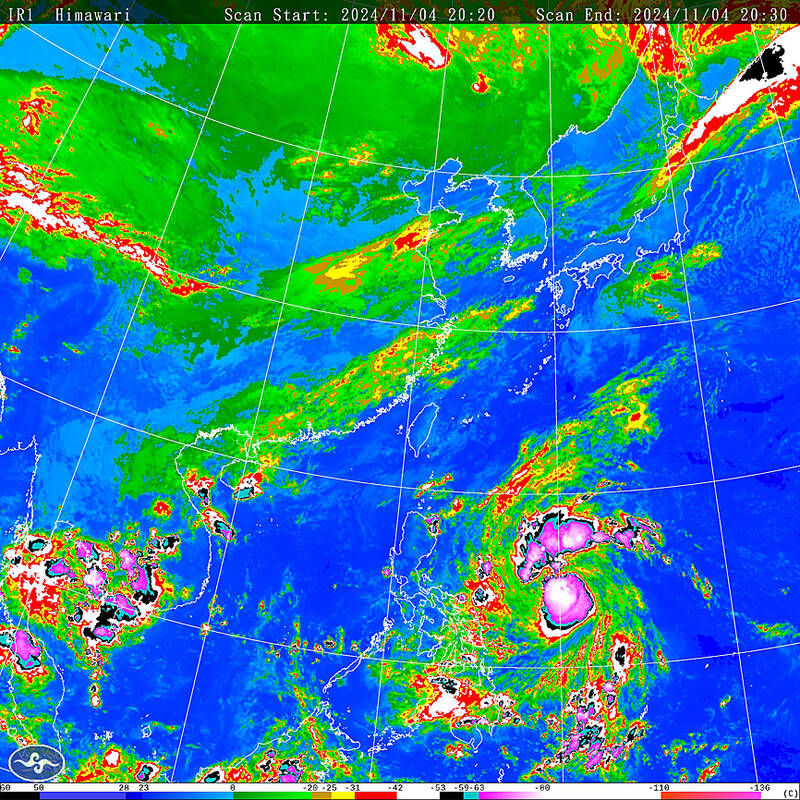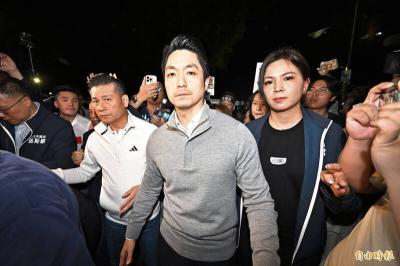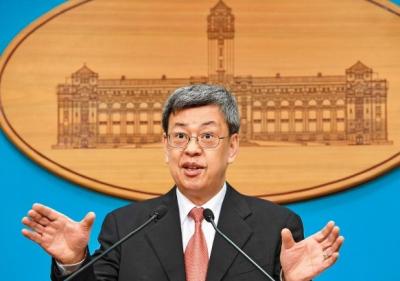A tropical depression east of the Philippines became a tropical storm early yesterday, the Central Weather Administration (CWA) said, less than a week after a typhoon barreled across the nation.
The agency issued an advisory at 3:30am stating that the 22nd tropical storm, named Yinxing, of the Pacific typhoon season formed at 2am.
As of 8am, the storm was 1,730km southeast of Oluanpi (鵝鑾鼻), Taiwan’s southernmost point, with a 100km radius. It was moving west-northwest at 32kph, with maximum sustained winds of 83kph and gusts of up to 108kph.

Photo: Screen grab from the Central Weather Administration’s Web site
Based on its current path, the storm is not expected to hit Taiwan, CWA meteorologist Huang En-hung (黃恩宏) said.
However, a more accurate forecast would be made tomorrow, when Yinxing is expected to turn toward the nation.
Independent meteorologist Daniel Wu (吳德榮) added that the CWA’s projection showed that the storm would move northwestward over the next three days and might slow as it approaches waters southeast of Taiwan.
Citing the latest European simulation model, Wu said Yinxing’s path remains uncertain.
It might drift westward to sweep across Luzon, the main island of the Philippines, into the South China Sea, or it could take a U-turn and head northeastward, he said.
In either scenario, the northeasterly seasonal winds are not expected to strengthen the storm, he added.
Meanwhile, Wu said seasonal northeasterly winds are forecast to bring rain to northern Taiwan today, with temperatures expected to drop to as low as 16°C tomorrow and on Thursday.

Several Chinese Nationalist Party (KMT) officials including Chairman Eric Chu (朱立倫) are to be summoned for questioning and then transferred to prosecutors for holding an illegal assembly in Taipei last night, the Taipei Police said today. Chu and two others hosted an illegal assembly and are to be requested to explain their actions, the Taipei City Police Department's Zhongzheng (中正) First Precinct said, referring to a protest held after Huang Lu Chin-ju (黃呂錦茹), KMT Taipei's chapter director, and several other KMT staffers were questioned for alleged signature forgery in recall petitions against Democratic Progressive Party (DPP) legislators. Taipei prosecutors had filed

Taiwan would welcome the return of Honduras as a diplomatic ally if its next president decides to make such a move, Minister of Foreign Affairs Lin Chia-lung (林佳龍) said yesterday. “Of course, we would welcome Honduras if they want to restore diplomatic ties with Taiwan after their elections,” Lin said at a meeting of the legislature’s Foreign Affairs and National Defense Committee, when asked to comment on statements made by two of the three Honduran presidential candidates during the presidential campaign in the Central American country. Taiwan is paying close attention to the region as a whole in the wake of a

NEW WORLD: Taiwan is pursuing innovative approaches to international relations through economics, trade and values-based diplomacy, the foreign minister said Taiwan would implement a “three-chain strategy” that promotes democratic values in response to US tariffs, Minister of Foreign Affairs Lin Chia-lung (林佳龍) said. Taiwan would aim to create a “global democratic value chain,” seek to capitalize on its position within the first island chain and promote a “non-red supply chain,” Lin was quoted as saying in the ministry’s written report to the Legislative Yuan submitted ahead of the legislature’s Foreign Affairs and National Defense Committee meeting slated for today. The Ministry would also uphold a spirit of mutual beneficial collaboration, maintaining close communication and consultations with Washington to show that Taiwan-US cooperation

President William Lai (賴清德) has appointed former vice president Chen Chien-jen (陳建仁) to attend the late Pope Francis’ funeral at the Vatican City on Saturday on his behalf, the Ministry of Foreign Affairs said today. The Holy See announced Francis’ funeral would take place on Saturday at 10am in St Peter’s Square. The ministry expressed condolences over Francis’ passing and said that Chen would represent Taiwan at the funeral and offer condolences in person. Taiwan and the Vatican have a long-standing and close diplomatic relationship, the ministry said. Both sides agreed to have Chen represent Taiwan at the funeral, given his Catholic identity and